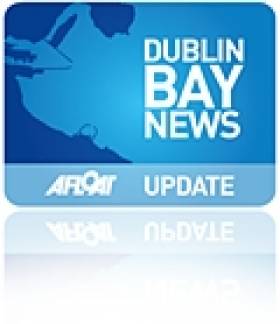Displaying items by tag: National YC
Shannon One Designs To Launch Centenary Year With Sold-Out Mad March Dinner in National YC
There are highly individualistic One Design Classes. And then there are the 1922-founded Shannon One Designs. They’re in a league of their own. And they’ll be launching their Hundred Year Programme for 2022 with a Centenary Dinner in the National Yacht Club in Dun Laoghaire Harbour on Saturday 5th March, with the class’s spirit being revealed by the fact that all tickets were sold out within 12 hours of the event being opened for business by Class Chairman Philip Mayne and Honorary Secretary Naomi Algeo.
Although the class races almost exclusively on the great lakes of the Shannon, it makes occasional excursions to other places like Lough Corrib in Galway and Lough Owel in Westmeath, while they made an impressive Dun Laoghaire debut in the sailing events of the 1924 Tailteann Games on Dublin Bay, when they returned home with the Gold Medal.
 The Shannon ODs have been providing close competition ever since their first race. It is believed to have been on Thursday 24th August 1922 on Lough Ree, though the first contest properly recorded was on Lough Bofin with the North Shannon YC on Tuesday 29th August 1922, won by Dr V Delany with Kiwi. Photo courtesy SODA
The Shannon ODs have been providing close competition ever since their first race. It is believed to have been on Thursday 24th August 1922 on Lough Ree, though the first contest properly recorded was on Lough Bofin with the North Shannon YC on Tuesday 29th August 1922, won by Dr V Delany with Kiwi. Photo courtesy SODA
Such is this una-rigged 18ft clinker-built dinghy’s unique appeal that owners are to be found in more than half of the counties of Ireland. And as many of them winter - so to speak - in Dublin, a Springtime seasonal opening get-together with gala overtones at the hospitable National Yacht club will fit the bill to perfection.
The class has long links with the NYC, as the Earl of Granard, NYC Commodore from 1931 to 1941, was also involved with County Longford’s North Shannon YC, one of the clubs which made an active input into the foundation of the class in 1921-22.
More recently, the NYC Commodore was Con Murphy from 2005 to 2008, and his wife – former Olympic sailor Cathy Mac Aleavey - is not only a devoted Shannon OD sailor, but she built her boat personally, working with the late Jimmy Furey, the legendary classic boat-builder of Leecarrow in County Roscommon.
 Olympic sailor Cathy Mac Aleavey, wife of former NYC Commodore Con Murphy, making knots with the Shannon OD she built with Jimmy Furey. Photo courtesy SODA
Olympic sailor Cathy Mac Aleavey, wife of former NYC Commodore Con Murphy, making knots with the Shannon OD she built with Jimmy Furey. Photo courtesy SODA
Olympic enthusiasm is one of the Shannon OD’s character traits, starting with Dr Alf Delany who sailed for Ireland in the 1948 and 1952 Olympics while at the same time being a leading helm in both the Dublin Bay Water Wags and the Shannon One Designs.
Afloat.ie’s W M Nixon, who will be one of the speakers at the Dinner in the NYC on March 5th, was introduced to the Shannon ODs by sailing with Alf Delany at the Golden Jubilee Regatta at Lough Derg YC in Dromineer in August 1972.
“It was remarkable sailing with Alf” he recalls, “it was as though he and the boat became one, and despite his tyro crewmate, we were in the frame in both races sailed. As for the Shannon One Designs as a class and as a colourful group of people, I was immediately mesmerized, and have remained so ever since.”
 Bendy boats do best…..Among the more fascinating aspects of the Shannon One Design is their hull flexibility in a good wind – “In a strong breeze, they’ll turn round and look at you”. Photo SODA
Bendy boats do best…..Among the more fascinating aspects of the Shannon One Design is their hull flexibility in a good wind – “In a strong breeze, they’ll turn round and look at you”. Photo SODA
UCD Sailing Alumni & Friends Event At National YC This February
The National Yacht Club will host UCD Sailing Club’s second Alumni and Friends Regatta on Saturday 2 February.
The event will involve a team racing round robin in the NYC’s Firefly dinghies, followed by a three-course dinner in the clubhouse.
All are welcome to join in the day’s events regardless of your alma mater.
Geraghty-McDonnell Leads Optimist Leinsters at National Yacht Club
Recently crowned Irish Optimist champion Rian Geraghty-McDonnell (14) of the National Yacht Club leads a blustery Leinster Championships hosted by his own club on Dublin Bay.
Four points behind, Royal Cork's Harry Twomey is second on seven, with Geraghty–McDonnell's club mate Nathan van Steenberge third on eight points in the 42–boat senior fleet.
Two races have been sailed in the relative shelter of Scotsman's Bay in blustery, north-westerly breezes reaching 20–knots and more at times but a third race was bandoned due to building winds in the late afternoon.
Racing continues tomorrow.
Full results for all three divisions are here
Dublin Bay Sailing Partnership Based on Artistic Endeavour
#iris – It has been said that keeping a boat-owning partnership intact is much more difficult than maintaining a marriage in a healthy state. Thus for most of us with the boat-owning vocation, sole ownership is the only way to go. But for others, in order to defray costs, increase boat size, and maybe leave more personal time free to pursue other interests, the ambitions can best be realised through one of a wide variety of partnerships and syndicates.
These can go through an extensive range, starting at one extreme with what amounts to time-sharing, with the large number of owners meeting (if they meet at all) only once a year for a sort of Annual General Meeting. Other possible setups can mutate through various arrangements where there is considerable overlap between the boat uses by the different owners, right through to the other extreme of total partnership where all owners sail together as often as is possible.
In some cases, the additional social glue of special shared interests is needed to give the partnership that essential extra vitality. There's nothing new in this. W M Nixon takes a look back a hundred years and more to a boat-owning group whose shared interest in art kept a 60ft ketch on a regular cruising programme around Dublin Bay and the nearby coastlines.
The 60ft gaff ketch Iris had a chequered career. She started life at the peak of the Victorian era in the 19th Century as a naval pinnace serving Dublin Bay, and she was presumably driven by steam. At the time, Dun Laoghaire – then known as Kingstown – was becoming the height of fashion as a naval port of call in the summer, made even more so by its convenient access to the centres of power in Dublin, and its strategically useful direct rail connection – pierhead to pierhead – to the main Royal Navy base in Ireland at Cobh on Cork Harbour.
However, as Kingstown had initially been planned solely as a harbour of refuge – an asylum harbor - for ships in distress in onshore gales, with the actual spur to its construction (starting in 1817) being the wrecking of a British troopship with huge loss of life at Seapoint on the south shore of Dublin Bay, the plans had included no provision for convenient alongside berthing for ships.
Indeed, you get the impression that the original underlying thinking was that there should be as little social contact as possible between ships sheltering in the new harbour and any inhabitants of its nearby undeveloped shore. But the rapid if somewhat chaotic growth of the makings of a new harbourside town, plus the advent of more rapid access from Dublin with the coming of the railway in 1834, soon meant that the top brass expected to be able to get off and on their ships in the harbour in style and comfort, and their Lordships of the Admiralty did not stint in providing large pinnaces for them to do so. When these pinnaces were replaced in due course by even more luxurious vessels, those shrewd amateur sailors who could visualise the older boats' potential as re-cycled government surplus found themselves looking at a bargain.
The Iris was originally built with lifeboat-style construction of double-diagonal hardwood planking, which was quite advanced technology for the time. For the can-do boatbuilders of the late 19th Century, converting such totally purpose-built craft into some sort of a yacht was all part of a day's work. Another similarly-built if smaller and different-shaped vessel, Erskine Childers' Vixen on which the Dulcibella of The Riddle of the Sands fame was based, was formerly an RNLI lifeboat with the standard lifeboat canoe stern. She was made more yacht-like by the addition of a staging aft to compensate for the absence of deck space just where you most need it, while underneath this new permanent staging, additional supporting planking was faired into the hull and – hey presto – you've a yacht-like counter stern.
Vixen also had a massive centre-plate complete with its huge casing, and carried more than three tons of internal iron ballast, all of which left little enough space for living aboard during the long and often rough cruise through the Friesian Islands which provided much of the on-the-ground material – and we can mean that in every sense – on which The Riddle was based.

Erskine Childers' Vixen (on which "Dulcibella of The Riddle" was based) in one of his last seasons of ownership in 1899. At first glance, she looks like a typical old-style cruising cutter of her era. But somewhere in there is a classic canoe-sterned RNLI lifeboat hull to which an afterdeck on a counter stern have been fitted as an add-on.
That cruise was in 1897, and shortly after it was completed, Childers went off to serve in the Boer War. This experience left him with doubts about the validity of the British Imperial mission, but equally left him in no doubt that on active service, there were no medals for enduring unnecessary discomfort. So by the time The Riddle of the Sands was published in 1903, Vixen was sold and he'd become a partner in a much more comfortable cruising boat, the yawl Sunbeam, which in turn was followed in 1905 by his very comfortable dreamship Asgard
Meanwhile, with the Iris a fifteen or so years earlier in Dublin, the conversion to a comfortable sailing cruiser was a more straightforward affair, as she'd a more versatile hull shape with a broad stern in the first place, and her new owner was one George Prescott, an innovator bordering on genius. He was an optical and scientific instrument maker, an electrical engineer and inventor, and a state-of-the-art clockmaker.
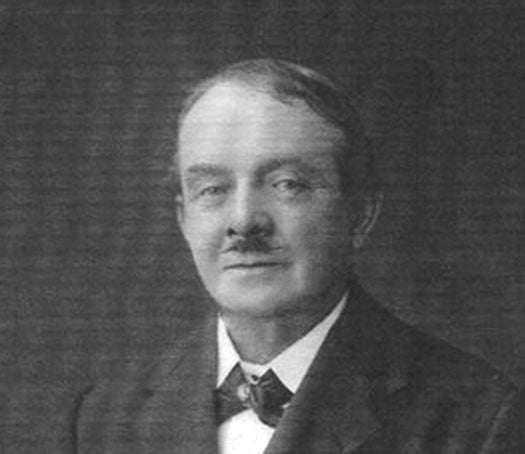
Man of many parts – the polymath George Prescott. Organising the Graphic Cruising Club and running its club-ship Iris was only one of his many interests. He led a long and extraordinarily interesting and varied life, and was nearly a hundred years old at the time of his death in 1942. Courtesy Cormac Lowth
But that was only one part of his life, for he had many friends among Dublin artists, particularly those interested in maritime topics, and he soon found himself to be the secretary of the Graphic Cruisers Club for sailing painters and sketchers, with the Iris becoming the base of their waterborne creative and scientific expeditions on the coast of the greater Dublin area.
She was ideal for this. She'd been converted for sailing with an orthodox gaff ketch rig, while her roomy hull was internally re-configured to have a galley with a large stove right aft, a huge saloon immediately forward of the galley to be both the clubroom and dining room, and sleeping quarters port and starboard in pilot cutter style forward of that.
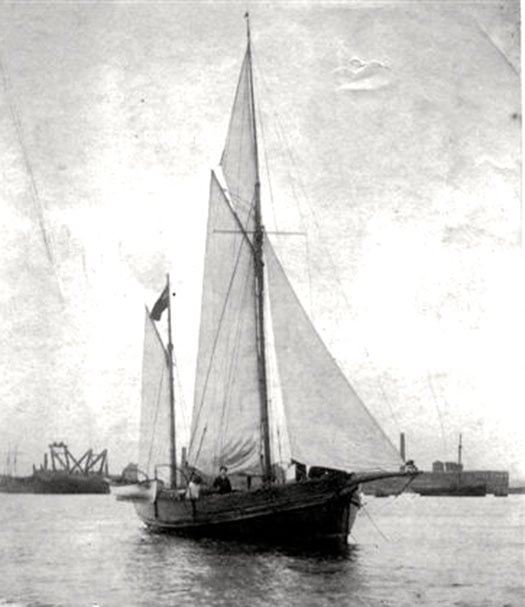
Quite a transformation for a former steam-powered naval pinnace. The 60ft ketch Irish in her heyday as the club ship of the Graphic Cruisers Club in the 1890s. She is at her home anchorage off Ringsend, while across the Liffey a couple of Ringsend trawlers are lying in the roadstead known as Halpin's Pool, where the Alexandra Basin is now located. Photo courtesy Cormac Lowth

Accommodation profile of the Iris in her days as the floating HQ of the Graphic Cruisers Club – this sketch by Alexander William first appeared in The Yachtsman magazine in 1894.
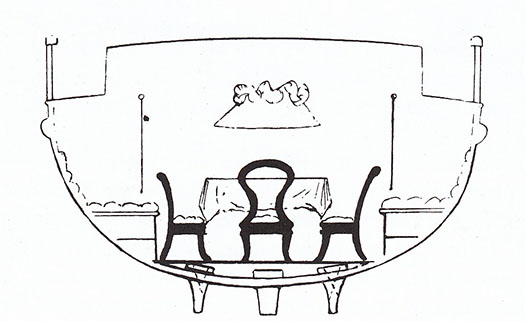
Hull section of the Iris at the saloon, showing the bilge keels which enabled her to dry out comfortably in some some little-known tidal anchorages in the Greater Dublin area.
But underneath the hull, the temptation had been resisted to add a deep keel, and instead the Iris was fitted with substantial bilge keels at the same depth as the shallow keel itself, such that in all she drew only about 3ft 6ins, and would comfortably dry out in a snug berth anywhere that her artistic crew felt they might find subjects worthy of their attention.
Thus she might overnight serenely on the beach at Ireland's Eye or far up the estuary at Rogerstown, and if the Graphic Cruisers Club attention was turned towards County Wicklow, she could comfortably take the ground in Bray or in other little ports inaccessible to orthodox cruising yachts. Yet the claim was that despite the odd arrangements beneath the waterline, she handled remarkably well on all points of sailing, and certainly as she no longer had any sort of engine, she must have sailed neatly enough to get out of some of the confined berths into which her eccentric crew enjoyed putting her.
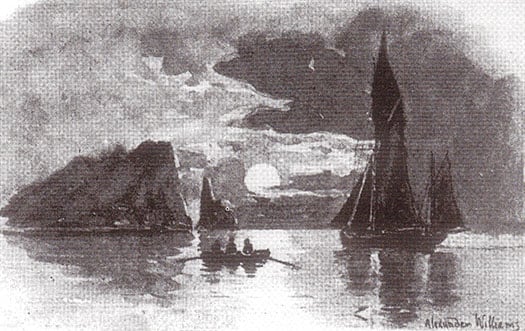
The Iris in gentle cruising mode off Ireland's Eye as the moon rises – this was sketched by Alexander Williams for The Yachtsman in 1894.
George Prescott seems to have been happy to claim that Iris was a club-owned yacht, but in truth most of his shipmates were impecunious artists of varying talent, so it was his generosity and understated business ability which would have kept the partnership together.
However, it really did seem to function as a partnership, for after the Iris project had been up and running for nearly a decade, he turned his attention in 1896 to building an unusual house on the waterfront on the Pigeonhouse Road in Ringsend, which he happily acknowledged to be the clubhouse of the Graphic Cruisers Club even if he lived in it himself.
Called Sandefjord for some reason which is still unexplained, it looked not unlike a smaller sister of the Coastguard Station next door, complete with a lookout tower. And it's distinctly nautical within, as much of the interior includes fine panelling which came from the wrecked Finnish sailing ship Palme, with the stairs being provided by the old ship's main companionway.
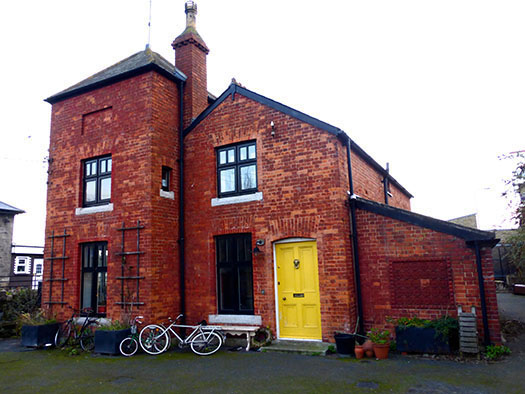
The house called Sandefjord near Poolbeg Y & BC as it is in 2015. When built by George Prescott in 1896, it faced across the Pigeonhouse Road directly onto the waterfront, and overlooked the summer anchorage of the Iris. Photo: W M Nixon
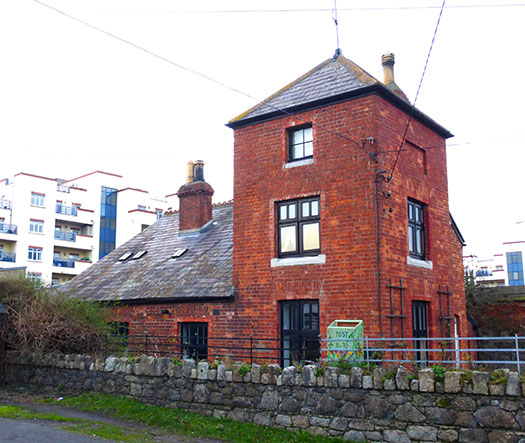
The design style of the Graphic Cruisers Club shore HQ at Sandefjord reflected the lookout tower of the old Coastguard Station next door. Photo: W M Nixon
The house has been restored to become a family home in recent years, and it really is an extraordinary piece of work to come upon on the slip road down to Poolbeg Yacht & Boat Club. Meanwhile, interest in the doings of the Graphic Cruisers Club has been restored by the formidable research talents and tenacity of Cormac Lowth, who single-handedly does more work in uncovering unjustly ignored aspects of Dublin Bay's maritime life in all its variety than you'd get from an entire university department.
I first came across a reference to the Graphic Cruisers Club years ago in an article in an 1894 issue of The Yachtsman magazine, written by Alexander Williams (1846-1930), who was probably the club's most accomplished marine artist. But that was then, this is now, and it has taken Cormac Lowth's dedication in recent times to get the extraordinary setup around George Prescott and Alexander Williams and their friends and shipmates into the proper context.
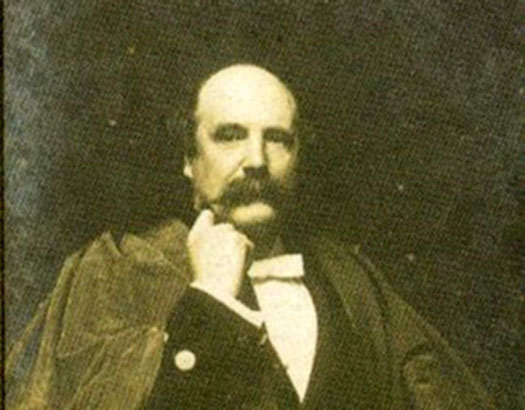
Alexander Williams RHA was the best-known artist in the Graphic Cruisers Club. A taxidermist of international repute, he was also a noted ornithologist, and his interest in maritime subjects was matched by his enthusiasm for landscape. He was one of the first artists to "discover" Achill Island in the west of Ireland, and in time he created a remarkable garden there in a three years project in which he personally worked shoulder-to-shoulder with the build team.
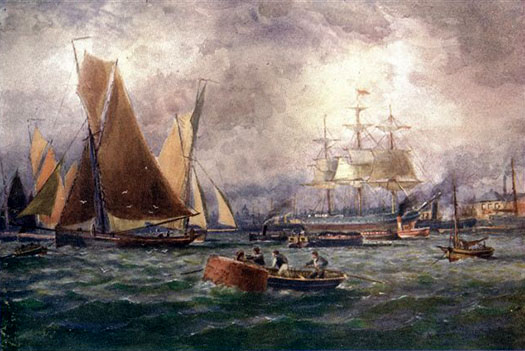
A classic Alexander Williams portrayal of the trawlers of Ringsend with other shipping in the Liffey. Thanks to research by Cormac Lowth, we are now aware of how the style of the Ringsend sailing trawlers came about through links, between 1818 and the 1914 outbreak of Great War, with the pioneering fishing port of Brixham in Devon, which was the most technologically advanced fishing port in Europe in the mid 1800s. Courtesy Cormac Lowth
They were larger than life, every last one of them, and Prescott and Williams in particular were renaissance men who could turn their hand to any number of creative projects at a time when life around Dublin was fairly buzzing for those with the energy and interest to enjoy it.
And there were links to other aspects of Dublin waterfront life which have a further resonance. Back in January, I'd to give one of the supper talks at the National YC in Dun Laoghaire, and on this occasion the topic was John B Kearney (1879-1967), the Ringsend-born yacht designer and boatbuilder who was the club's Rear Commodore for the last 21 years of his life.
You need some sort of special little link to bring these talks to life, but fortunately I remembered that there's a fine big Alexander Williams painting of sailing trawlers at Ringsend in the NYC's dining room. I didn't know its date as we headed round the bay on the night of the talk, but we struck gold. It was dated 1890.

The Brixham style in Ringsend was best exemplified by the largest trawler built in the Dublin port, the St Patrick (right) of 53 tons built in 1887 in the Murphy family's boatyard beside the mouth of the River Dodder. The Murphy family also owned and operated the St Patrick in her fishing, and when John Kearney built his renowned yachts, the earliest (and best) of them were built in a corner of Murphy's Boatyard - the Ainmara in 1912, the Mavis in 1925, and the Sonia in 1929. Photo courtesy Cormac Lowth
Williams was so fond of the Ringsend scene that he lived there for a while in Thorncastle Street where John B Kearney was born, and of course the painter subsequently sailed regularly from the old port in the Iris, and would have over-nighted at Sandefjord too. He is in fact the definitive Ringsend maritime artist, and the picture in the NYC expresses this. And as it includes some of the Ringsend waterfront, we could say that it also includes John B Kearney, for in 1890 the precocious eleven-year-old Ringsend schoolboy was in the boatyards as much as possible, as he had already stated in his quietly stubborn way that his ultimate ambition was to be a yacht designer.
Not a boatbuilder or a shipwright or a harbour engineer, which is nevertheless what he was until he retired in 1944. But upon his leaving the day job - in which he'd been highly respected - he then devoted all his energies to what he had been doing all his life in his spare time. And with his death aged 88 in 1967, his gravestone in Glasnevin cemetery said it all: John Breslin Kearney (formerly of Dublin Port & Docks Board) Yacht Designer.
And if you wonder how on earth we have come to a consideration of John Kearney's memorial stone in an article which purports to be about the social glues which keep boat partnerships in good order, believe me when you get involved with the boys of the Graphic Cruisers Club you never know where it's all going to end.
We've already discovered that in later life Alexander Williams devoted much energy to his garden in Achill while at the same time continuing to be an active member of the Royal Hibernian Academy in Dublin. As for George Prescott, he too broadened his already extensive interests, and in his eighties he was much into amateur opera production, even being so deeply involved as to paint the stage scenery himself.
Dublin too was expanding, so he accepted that a move eastward was needed if he was going to be able to continue to commune directly with his beloved sea. So he left Sandefjord, and the final decades of his wonderful life were spent at his new home at The Hermitage on Merrion Strand. Needless to say, Alexander Williams provided him with a painting of The Hermitage which captured the then unspoilt nature of a place you'd scarcely recognize today.
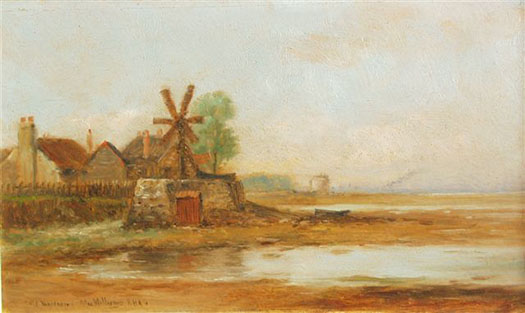
The Hermitage on Merrion Strand, George Prescott's last home as portrayed by Alexander Williams. Courtesy Cormac Lowth
Boating Visitors To Ireland's South Coast Get Mixed Welcome Messages
#marinetourism – Ireland's south coast provides an almost infinite variety of harbours, natural havens, and extensive areas of interesting sailing water. These cater for boat enthusiasts of all kinds, with craft of every type. So how does the welcome for visitors shape up? W M Nixon contrasts the different hospitality styles of four attractive ports.
The word on the grapevine that the Ballydehob Old Boat festival had taken place arrived with an intriguing photo from Anthony O'Leary. It had been noted in the interview with him immediately after he had led the team in Ireland's Commodore Cup Victory, that while he was trying to unwind for a while, it's not really in the O'Leary makeup to relax, and soon his mind was busy with new ideas of nautical interest.
Nevertheless he was cruising gently in early August down towards West Cork in the family's handsome big Nelson powercruiser Irish Mist, a fast and able vessel which his father Archie and mates like Mick Ahern once took right round Ireland in a settled springtime spell of weather, just to be in Dublin to watch Cork Con play rugby in some major championship at Lansdowne Road.
As it turned out, this year Irish Mist was getting down west ultimately to be in Baltimore for the 1720 Nationals in late August, which O'Leary duly won. But from time to time, he flashed back some photos of interesting boats met along the way, and one which really rang the bell was a little Ette Class clinker-built gunter-rigged sloop sailing in Castlehaven.
The Ette class originated way way back, when two keen dinghy cruising types sailed their little dinghy into Castlehaven, and the Castletownshend locals in the South Cork Sailing Club were so taken by the boat that they commissioned the waterfront boatbuilders, the O'Mahony brothers, to build some sister ships as the basis of a class.
All the new boats' names ended in "ette". And the class survived for many years, though at times the Ettes were hanging on by a thread. But recently it has had a fresh lease of life with new examples of what is now a classic dinghy being built by Lui Ferreira of Ballydehob, who last came through this parish when, in 2012, he put the first teak deck on a vintage Howth 17, the syndicate-owned Deilginis.
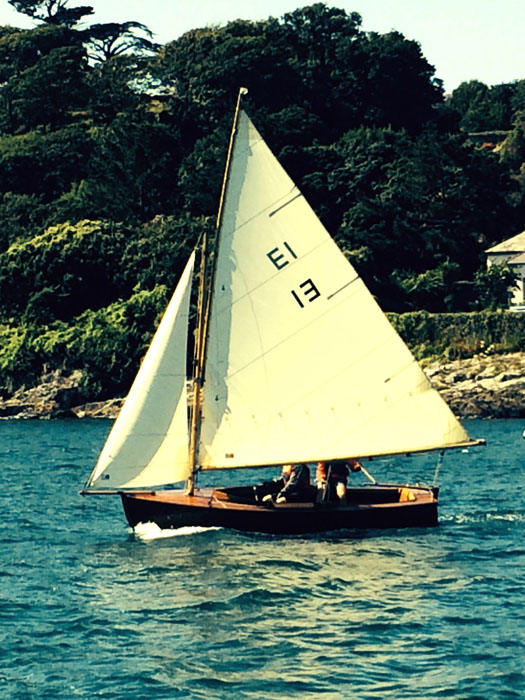
Perfection of summer – an Ette class in her home waters of Castlehaven. Photo: Anthony O'Leary
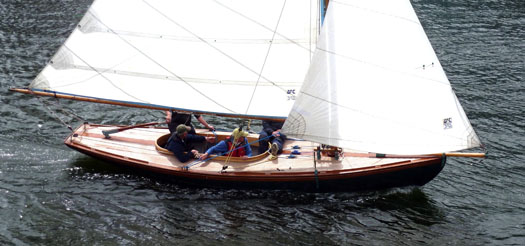 Rui Ferreira, builder in Ballydehob of the Ette Class, also put this teak deck on the 107-year-old Howth 17 Deilginis in 2012. Photo: W M Nixon
Rui Ferreira, builder in Ballydehob of the Ette Class, also put this teak deck on the 107-year-old Howth 17 Deilginis in 2012. Photo: W M Nixon
A Howth 17 looks well no matter how you photo her. But an Ette is a quirky little thing which can sometimes look odd from the wrong angle. Yet in a flash of inspiration, the Captain of the Commodore's Cup team took up his iPhone as an Ette came bustling down Castlehaven on fine sunny morning, and we got what I reckon to be one of the best photos of an Ette under way ever obtained – plus it gets the very essence of summer in Castlehaven.
The next O'Leary snap some days later was just briefly titled: "The Ballydehob Old Boat Festival, Irish Mist in archway second left". What was going on here? We'd heard vague stories about a very relaxed assembling of boat at high water at the drying quay at Ballydehob, but the O'Leary photo hinted at serious numbers and a high level of organization.

The teaser photo – first intimations of this year's Ballydehob Gathering of the Boats, with the O'Leary family's motor-cruiser Irish Mist (framed in the second arch from left) joining an eclectic group of 74 boats for a couple of hours at top of the tide. Photo; Anthony O'Leary
 This is most people's image of Ballydehob, crowded and very rural, with Mount Gabriel beyond. Only the more observant will notice the tidal river in the foreground. Photo: W M Nixon
This is most people's image of Ballydehob, crowded and very rural, with Mount Gabriel beyond. Only the more observant will notice the tidal river in the foreground. Photo: W M Nixon
To begin with, most casual visitors would scarcely think of Ballydehob as a seaport at all. Rather, it's the very essence of rural West Cork, a crowded little village where "laid-back" is the default mode, and it has been so for some time. It reached something of an apotheosis when Annie Barry (she's one of the Fergusons of Gubbeen Cheese) was running her wonderful Annie's restaurant on one side of the winding main street, and the Levis sisters Julia and Nell, feisty little ladies of mature years, were running Levis's pub across the way.
Julia and Nan were splendid folk of considerable standing, and it's said the pair of them were once squired to the West Cork Hunt Ball in Skibbereen by Jeremy Irons of Kilcoe Castle a few miles along the coast. As for the setup in Ballydehob, space was so limited in the restaurant that, having checked out your booking, you simply took up station in leisurely style across the street in the pub with Annie's menus and an aperitif or two, then Annie would come across the road and discuss your order, and a delightful evening would continue late into the night.
Alas, for some year now Annie's has been closed, though everyone lives in hope of somebody re-opening it. And in the pub, the old ladies have passed on. But now it's run by a great-nephew, and very successfully too. We got ourselves in there late on a velvet July evening this year to find the place was heaving with youth and beauty and high fashion in casual style - achingly trendy it has become.
It could have been a traditional local in any of the world's fashionable holiday areas except for one thing. A ball of fur, a terrier of some kind, emerged from among people's legs and barked its head off at me. I assumed it was because I carried a whiff of our own little Jack Russell. But the blushing girl owner told me with a big smile that her little dog must have thought I was a priest. Only along Ireland's south coast, near some former or still surviving Protestant enclave, would you have heard that particular excuse.
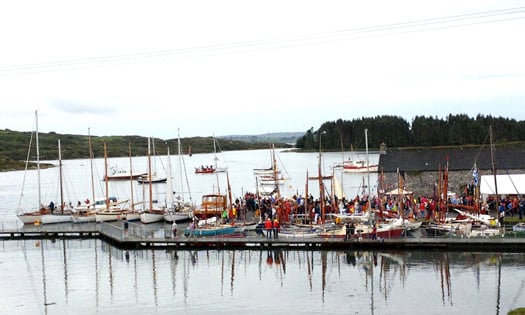 The old dock at Ballydehob is well able to receive a very varied fleet, seen here from the old railway viaduct Photo: Miriam Jones
The old dock at Ballydehob is well able to receive a very varied fleet, seen here from the old railway viaduct Photo: Miriam Jones
Just along the river from these scenes of hospitality and minor mayhem, immediately below the mighty railway viaduct which seems to be so disproportionate for the long-gone needs of the little West Cork Railway, there's Ballydehob Harbour. Time was when it was key to the place's economy, and it was in the late 1930s, only a year or so before World War II, that the Brooklands, the last surviving sail-only coasting schooner to deliver cargoes to West Cork, made her way up the winding estuary at the head of Roaringwater Bay (it's named for the Roaringwater River, much of the bay behind Carbery's Hundred Isles is well sheltered), to anchor just off the quay, as she was too deep to berth alongside.
The Brooklands was owned and skippered by Tom Creenan of Ballinacurra in the inner northeast reaches of Cork Harbour, but it was from Birkenhead or Goole on the Mersey that she'd bring her welcome cargoes of coal, a challenging passage at the best of times. At Ballydehob, while smaller cargo-carriers could get alongside the old quay, the Brooklands discharged her cargo into the multi-functional barge-type vessel known the Sandboat.
She was used by her owners, the Levis family, for just about everything, but primarily for going out among the islands towards high water, running up on a clean beach, then laboriously shovelling sand into the hold until the tide returned and the Sandboat could be floated off and piloted back to the quay where her eventually very useful cargo would be shovelled ashore to become builders' supplies.
The Sandboat was Queen of the Fleet at Ballydehob, and she played such a central role in the Levis family's life that Old Boat Festival organiser Cormac Levis's brother calls his pub in Ballydehob the Sandboat.
As for how Cormac himelf first got the notion for the Ballydehob Gathering of the Boats, he has been a tower of strength in the Traditional Boat movement, particularly in West Cork but also throughout Ireland, for many years. And with others following his example in restoring or even building new sailing lobster boats to traditional design, he suggested that getting together at Ballydehob during the little town's time-honoured summer festival around August 15th might hit the spot. And for the first one in 2004 –making this year's the tenth anniversary - they assembled nine boats, which was considered pretty good going.
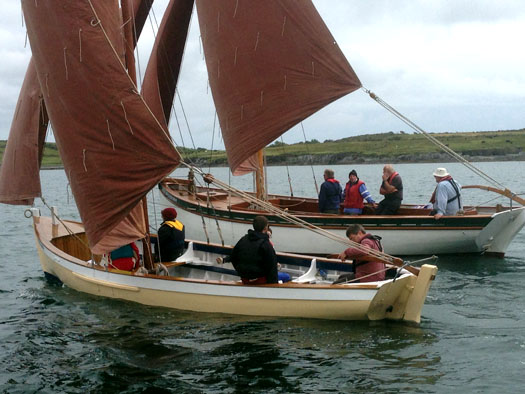
Close-up on Cormac Levis's lobster boat, which led the way for the first gathering of traditional craft at Ballydehob in 2004. Photo: Brian Marten
From it, they learnt that, for the future, while the aspiration would of course be for quiet and easy-going organization under a light hand, underneath it all there'd have to be efficiency, always with an eye on the clock. Although the tidal window is more than two hours for most boats, they've successfully accommodated modern yachts up to two metres draft without anyone being left behind stuck on the mud. But with limited manoeuvring space in both the harbour area and the channel, once the witching hour of high water is upon the fleet, it's time to start thinking about an orderly departure after two solid hours and more of good crack, mighty barbecues, and much interest in an examination of other people's traditional and classic boats.

Even among the sister-ships of the lobster fleet, many individual variants in hull lines and rig are apparent. Photo: Brian Marten

Just to add to the variety and colour, the Ilen Trust from Limerick brought their much-travelled Shannon Gandelows (right) to Ballydehob. Their stylish pennants are a legacy of heir successful visit to Venice at the end of April this year. Photo: Gary MacMahon
So the crucial thing is to select the ideal Saturday nearest to August 15th with a good big tide in mid-afternoon. As the Boat Gathering is such a force in its own right, they can range quite extensively on either side of August 15th, and to date the earliest has been August 8th, while the latest was August 21st.
This year's was Saturday August 9th, and while there may have been rain later in the day despite West Cork having much more sunshine in August than almost any other part of the country, no-body now remembers the rain as they recall the sheer fun and sense of community of what has been described by Tiernan Roe, another of the quality boat-builders of Ballydehob, as the "shortest bestest Boat Festival in the World".

Yet another creation of the active Ballydehob boat-building scene. This is an attractive little Cape Henry 21 cutter lunched in June by Tiernan Roe of Roe Boats. Photo: Tiernan Roe
For this year, it attracted 75 boats, though admittedly last year's record entry of 50 boats was greatly enhanced by this year's decision by the Drascome Lugger Association to combine Ballydehob in their 2014 cruise-in-company in West Cork, thereby adding 27 boats at a stroke.
But even with 27 boats of one class, the variety across the fleet as a whole was remarkable. So how do they assemble such a disparate fleet of boats with obviously highly-individual skippers, in such a quietly efficient way? For you'll never see or hear the Ballydehob Gathering of the Boats being publicly advertised all that much beforehand.
The method is perfectly simple. Everyone with an interest will know it is likely to be coming up on the agenda. So a month and more beforehand, Cormac will text them with the final date on a need-to-know basis. It works, and it sets the tone of quiet consideration for others and their boats in a very special festival in which some quiet sponsorship by CH Marine and West Cork-based German traditional boat fan Thomas Drewes sees that all participants get mementoes including cherished T-shirts (definitely not for general release), while barbecue facilities keep the good humour buzzing until everyone departs in style for their anchorage for the night, for although most boats hope to be berthed in Ballydehob on the big day more two hours hours before high water, once the ebb has started the channel has become much less forgiving about any pilotage errors.
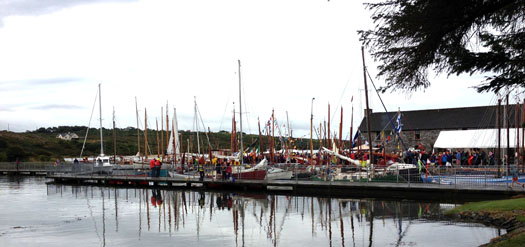
They're all here, as neatly berthed as you could please, but getting them away as the ebb starts requires good seamanship and boat-handling skills. Photo: Miriam Jones
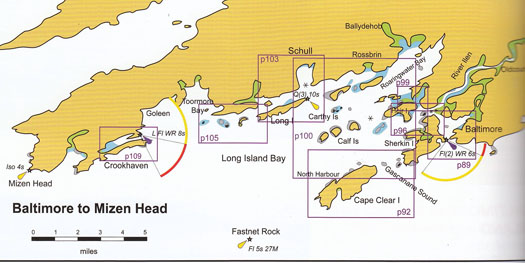
Ballydehob's central position in a hugely varied and welcoming crusing coast is emphasized by the number of other harbour chartlets indicated in this plan of the prime cruising area of West Cork. Plan Courtesy Irish Cruising Club
It's good to see a locally-focussed event like this now coming of age with a very healthy turnout. Eastward along the south coast, last weekend saw another event which will surely grow in stature and numbers, the second staging of Y2V Cruise-in-Company on the River Blackwater up the estuary from East Cork to West Waterford, as a flotilla of ten boats - eight GP14s, a Mermaid and a Feva – sailed up-river from Youghal to Villierstown.
It has been promoted by Youghal schoolboy GP 14 skipper Adrian Lee, and last year the inaugural tiny flotilla managed most of the sailable river by going to the bridge at Cappoquin before returning downriver to Villierstown. This year it achieved deserved support from the GP 14 class, with the furthest road-trailed from sea level being incoming Irish GP 14 Association President Stephen Boyle from Sutton DC, while the furthest-travelled in terms of elevation above sea level were the Blessington group, who came down from the Wicklow Hills with their Geeps and included Richard Street and kids (see again this blog on 26th July), and a brand new Duffin boat belonging to Simon Culley and Libby Tierney.
As for seniority, the classic of the class was a 60-year-old beautifully-restored Bell Woodworking GP 14 owned and skippered by 16-year-old Jack Nolan, another of that group of Youghal youngsters who are taking local dinghy sailing forward with gusto, while further variety was provided by Norman Lee of Greystones, his crew including the inevitable family pooches which are such a part of the GP 14 scene.
The sailing was mixed – as Norman said, in a river the wind will always be ahead some time, and though we think of the secret Blackwater Estuary as being fairly straight, in fact there are some quite significant curves. It took about four-and-a-half hours to sail up, and a brisker four hours to return on Sunday morning's ebb.
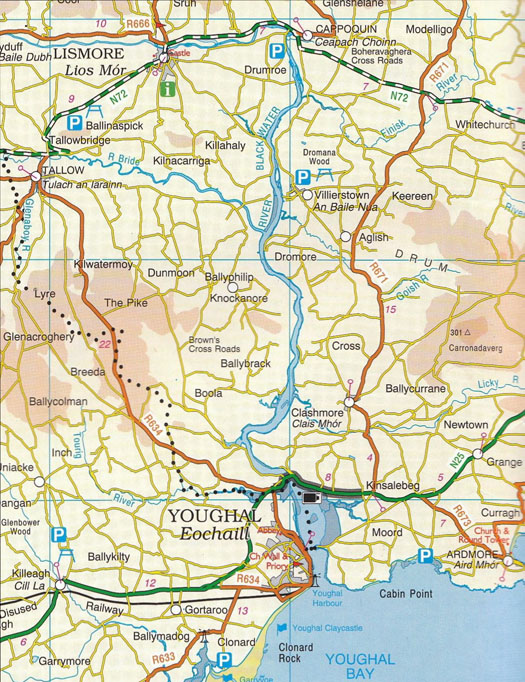
The secret waterway – the Blackwater Estuary from Youghal up to Cappoquin and almost to Lismore is one of Ireland's least-sailed rivers

Villierstown's new clubhouse, open only three weeks, was ready and willing to make welcome the crews who had sailed up from Youghal. Photo: Norman Lee

The new facility, Villierstown's "floating pier"
(right), was originally the in-harbour pontoon at Dungarvan SC. Photo: Norman Lee
At Villierstown, the new clubhouse of the Villierstown Boating & Activites Cub had been open only three short weeks, but they've made good use of a sports council grant, and it well fulfills a multi-purpose role, including providing the hospitality needed by sailing campers, with Paul Virtue and his wife Caroline organising a fine feast in the clubhouse on the Saturday night, and an enormous breakfast on Sunday to send them on their way downriver to round out an event which has future annual success written all over it.
One of the reasons it all went so well was that the slightly cogglesome little plastic floating jetty, along which the sailors of Villierstown used to access their small boats, has been replaced by a proper pontoon which the club acquired when Dungarvan SC eastward along the coast up-graded their in-harbour pontoon. In fact, Dungarvan support for the development of Blackwater sailing didn't stop there, as one of the fleet in the Y2V was a vintage Dungarvan-based Mermaid in which owner Eugene Burke has cruised the entire south coast between Ballycotton and Kilmore Quay.
The boat is Akita, Mermaid No. 85, and she has certainly been around, as she was built in the Barkyard in Skerries in 1953 by Joe and Matt Boylan. The Barkyard was originally the place where the Skerries-based coasting schooners and fishing boats had their sails preserved against rot by tanning with bark, but in the 1950s the now redundant premises were used to build some of the eventually enormous fleet of Skerries Mermaids through a boat-building class run by the colourful Jem Kearney.
The Fingal region around Skerries and Rush continues to be the great heartland of the Mermaids, with some very racy boats built in the old mill at Rogerstown recently, but despite the modern challenge, this year's Mermaid Week at Rush saw the champion emerge in the form of Jonathan O'Rourke of the National YC with his vintage boat, one of the few Mermaid sailors still in Dun Laoghaire.

The welcoming port. Despite its tidal limitations, Dungarvan lays on the welcome in a big way. This shows a visiting fleet at the original pontoon, which has now been moved to Villierstown. Photo Kevin Dwyer, courtesy Irish Cruising Club
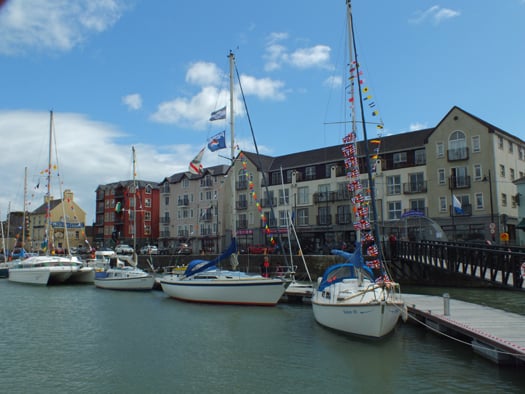
Dungarvan SC's new in-harbour pontoon has much improved the alongside berthing space, but unfortunately the local Council wouldn't permit dredging to improve access.......Photo: Donal Walsh

....and thus the reality for most boats in the Inner Harbour is a drying berth.......... Photo: W M Nixon
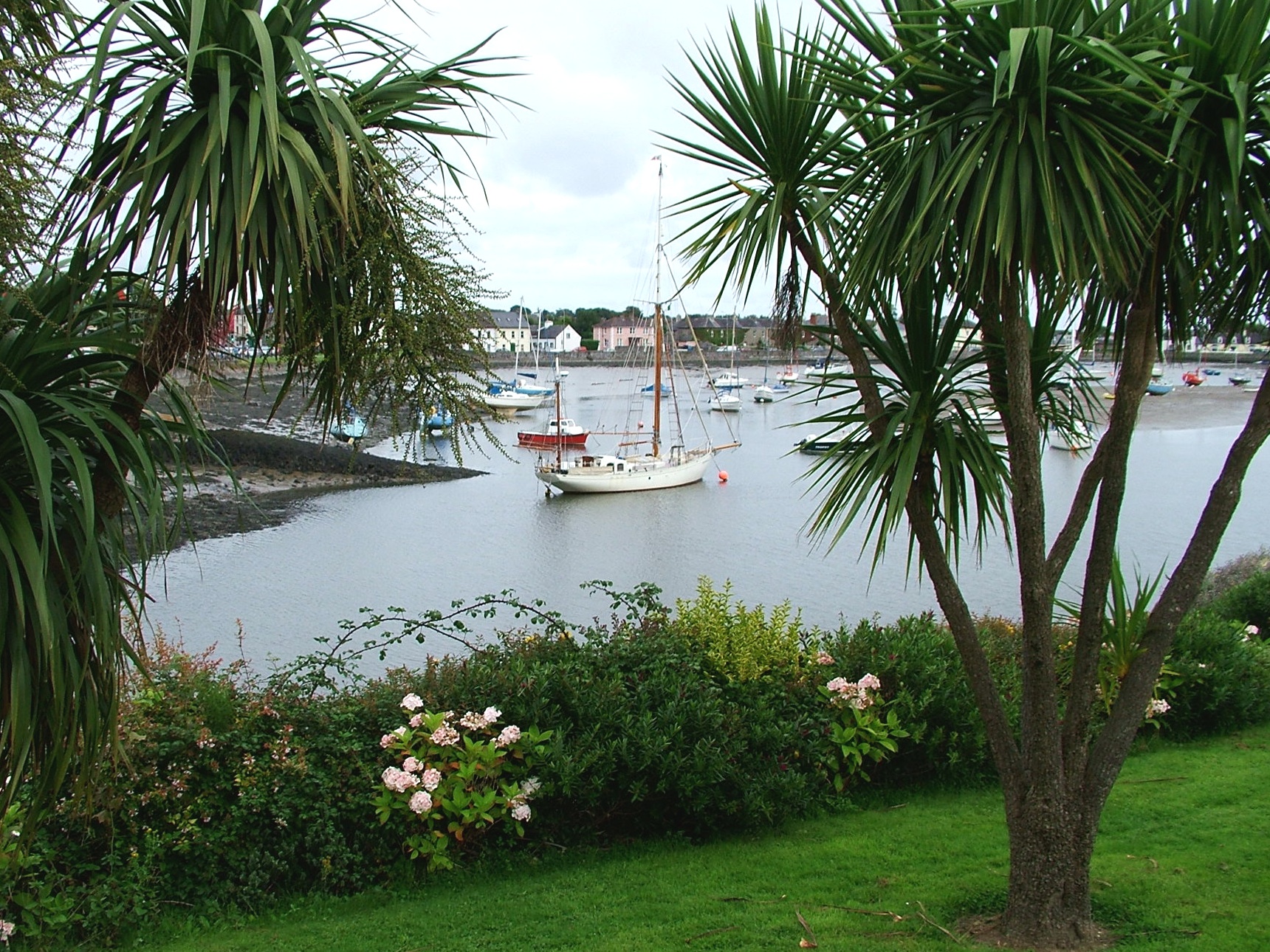
....but if you've access to local knowledge, there is a deep pool just below the bridge........Photo: Donal Walsh
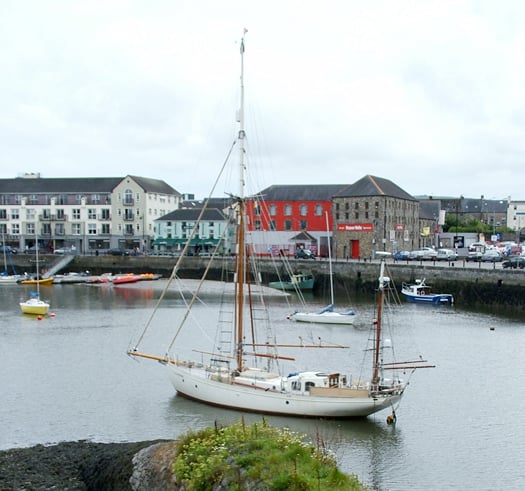
.....and here the Northwest Passage transiting 44ft steel gaff yawl Young Larry is visiting in comfort and style. Photo: Donal Walsh
Meanwhile in Dungarvan the club's hopes of doing a bit of dredging to improve access to their extended in-harbour pontoon was stymied when the council said they wouldn't permit any salt-contaminated sludge being brought up onto the quay. But despite its tidl limitations, it's a hugely hospitable place, and if you do take the ground at the pontoon, it's mostly soft and forgiving mud which enables you to sit in relative comfort. Certainly some very substantial cruising boat have overnighted here to enjoy the fine pubs both on the waterfront waterfront and in the town, while culinary standards are set by Paul Flynn's famous restaurant The Tannery just round the corner.
Nevertheless if you absolutely won't let your boat dry out, leading Dungarvan cruising man Donal Walsh (he has just returned from an epic round Ireland and Britain clockwise cruise with his Moody 31 Lady Kate) well knows the deep pool across the harbour close under the bridge, and he saw to it that his brother-in-law Andrew Wilkes and sister Maire Breathnaith found a secure berth there for their hefty 44ft steel-built gaff yawl Young Larry, a boat in which they transited the Northwest Passage, but she looks well at home in Dungarvan with its fine tradition of first class locally-based trading schooners.
In moving along the south coast, we find that when possible, they'll lay out the welcome mat big-time in Ballydehob, Youghal, Villierstown and Dungarvan, despite the fact that all four places are restricted in what they can do by the exigencies of tide.
So how are things working out in Dunmore East, the one port which has the potential to be one of the most welcoming and accessible all-tide sailing and fishing ports along the entire south coast?
Despite this potential, the under-development of its facilities, fuelled by a sometimes poisonous attitude between fishermen and other harbour users, has provided recreational visitors with often unpleasant memories. In trying to understand why this might be so, we have to understand how Dunmore East came to get its pretty little harbour. When it was built in the first half of the 19th Century, it was not – as is commonly supposed – built for the benefit of fishermen. The horrible fact is that fishermen came so far down the pecking order that they just had to make do for themselves as best they could.
The handsome new pier at Dunmore East, designed by Alexander Nimmo who is best known for developing Tobermory in Scotland and many places in Galway including Roundstone, was constructed exclusively for the use of the new fast sailing cross-channel packet boats serving the top people of Waterford in their trading and communication with Britain, while the unfortunate local fishermen were forced to keep their boats in the limited shelter of The Cove to the north of it, and haul them on the exposed beaches at The Strand and Councillors Strand.
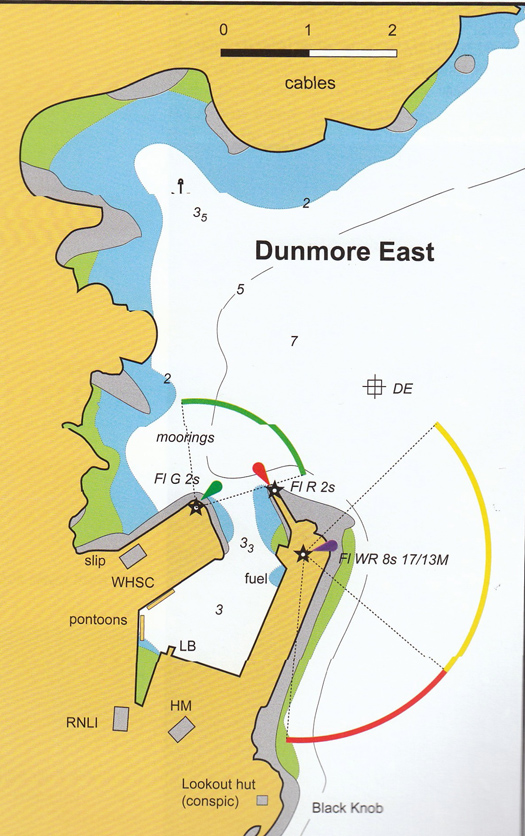
Dunmore East's substantial pier was new-built originally to provide a port for cross-channel sailing Packet Boats, serving Waterford ten miles up the road. When this was its primary function, any local fishermen were banished to the poorly-sheltered coves to the north, with their boats being hauled up on the exposed beaches beyond. Plan courtesy Irish Cruising Club
Soon, however, steam driven packet boats were able to go conveniently all the way up to Waterford, and Dunmore East was redundant as a packet-boat harbour. But it was only with reluctance that fishing boat were allowed to start using it, as the Royal Navy would have been keeping an eye on its possibilities for their own occasional use.
Yet down the years, the idea has developed that Dunmore East was always primarily a fishing harbour, and to a lesser extent the same attitude prevailed at Howth on the east coast, where the new harbour functioned as the Packet Boat station for Dublin only between 1817 and 1826, when the developing new asylum harbour at Dun Laoghaire became the selected port for the Royal Mail's new paddle steamers serving the cross-channel route. Yet the silted harbour at Howth was only allowed to become a "fishing station" in the 1850s.
The legacy of all this, in Dunmore East at any rate, is that there still seems to be a suspicion among the fishing community that their tenure is only temporary, that the powers-that-be would move them out if they see a better use for the place. How else can we explain the negative and almost paranoid attitude of the fishing spokesmen every time a suggestion for a much-needed marina at Dunmore East is put forward?
With all this in mind, I made a quick visit to Dunmore East in mid-August while on other business in the southeast, in the hope of seeing if a much-trumpeted €4 million dredging scheme was now in progress in the harbour, and also to see how an equally celebrated new Visitors Pontoon along the East Pier was working out.
The photos speak for themselves. There wasn't any sign of a dredger, though doubtless that will turn up in due course. Yet as for the 40 metre pontoon, it's not a leisure-boat-friendly neat little piece of work at all, but is quite a massive and brutal steel box structure more suited to rugged fishing boats, who were showing their approval by using it so totally that the only leisure visitor was a German motor-cruiser which had managed to squeeze in at one end.
But as this pontoon is on the wrong side of the harbour for ease of access to the Sailing Club on the west side, and the welcoming facilities in the village above it, any pedestrian boat visitor – the vast majority of incoming leisure boaters, in other words – has a long trek through the sometimes crowded and malodourous delights of a fishing port before they can access any amenities. So not surprisingly the German boat had its inflatable tender moored outside it for quick and easy movement across the harbour, and along to the beaches if wished, a situation which inevitably precluded any other newly-arrived boat from rafting up alongside
So for any cruising boat coming in from sea, often with the challenge of Hook Head just recently put astern, it wasn't a welcoming setup. In fact, it was downright hostile. While we were there, an ordinary sailing cruiser with happy folk aboard came motoring from the eastward to round the end of the pier after stowing their sails, but their hopes of a convenient and enjoyable visit to Dunmore East were soon dashed. No welcoming RIB came out from the sailing club to direct them to a vacant mooring, as there probably wasn't one. And as for the pontoon, "unwelcoming" is inadequate. It clearly didn't want anything to do with them. You could see their spirits wilting as they headed out, faced with the long haul up to the marina in Waterford City. The current visitor berthing situation in Dunmore East is at the very least a sad business, so where does it go from here?

Dunmore East in mid-August. No sign of any dredging, and the "Visitors Pontoon" under the lighthouse on the East Pier is packed out with fishing boats.......Photo: W M Nixon
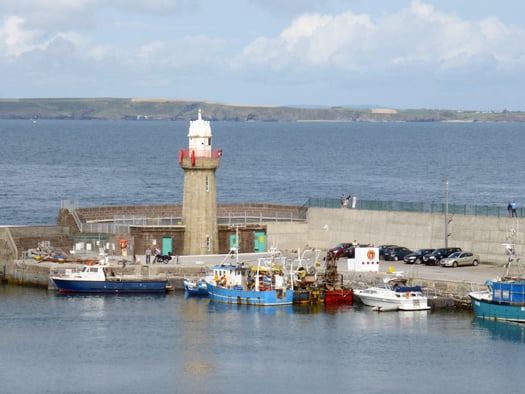
........and just one visiting German motor cruiser which was protected against any rafting up by its tender on the outer side. Photo: W M Nixon

The new pontoon is an industrial standard piece of kit......Photo: W M Nixon
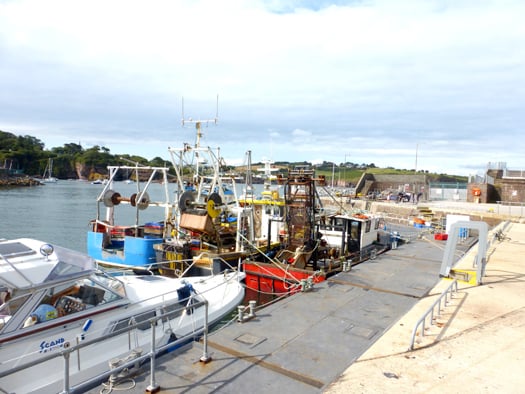
....and understandably very popular with active fishing boats. Photo: W M Nixon

But for visiting sailing boats newly arrived in port.......Photo: W M Nixon
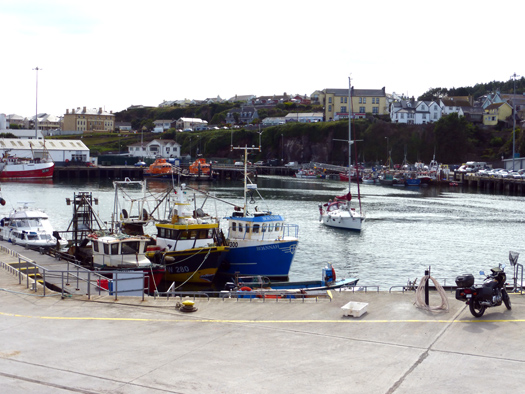
....it's soon clear that there isn't really a welcoming berth for them.....Photo: W M Nixon
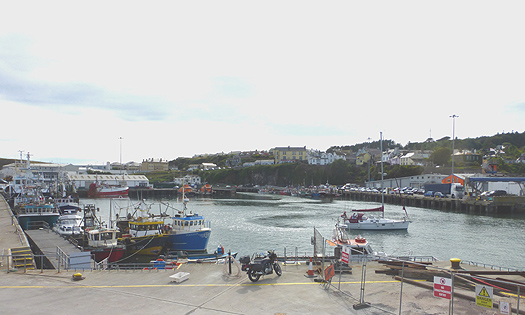
....and they head out to sea again, visibly disappointed by their Dunmore East welcome. Photo: W M Nixon
#routedesprinces – A fleet of some of the fastest sailing craft in the world will make an attempt on the Round Ireland Speed Sailing Record next month.
The giant 70-foot Route Des Princes multihulls which race to Dun Laoghaire (June 20-23) in a stage of their innovative Round Europe race will now also take in a Round Ireland speed challenge when the fleet departs Dublin Bay on June 24th.
Irish World speed sailing commissioner Chris Moore confirmed the bid for the prestigious National Yacht Club trophy and the World Speed sailing record last night.
'Sylvie Viant of the race organisers has confirmed that the boats will compete for both the WSSR record, and also the National Yacht Club's own "Round Ireland" record, to beat Lakota's time in September 1993 of 1 day, 20 hours and 42m', Moore told Afloat.ie
Speed sailing fans will recall Damian Foxall's aborted bid in March when the giant Omansail MOD trimaran came to break the record but was beaten back by strong winds. At that time the Kerry Round the world race winner promised to return and this June (if the weather gods permit) it looks like Foxall will make good on his commitment to challenge the 20–year–old record set by the late adventurer Steve Fossett.
It is understood the fleet of six or seven multis will depart the bay on Monday 24th June but instead of heading directly to Plymouth on the next leg of Route Des Princes they will take in a north or southabout circuit of Ireland as part of the course. The record times will be taken at the Kish lighthouse at the entrance to the bay.
In Early Sept 1993, the 60ft. trimaran 'Lakota' shattered the previous record for the fastest circumnavigation of Ireland by almost one full day.
Sailing with a crew of 5 – American co-skippers Steve Fossett and David Scully, English yachtsman Brian Thompson and Irish husband and wife team, Con Murphy and Cathy Mac Aleavey from the National Yacht Club – "Lakota" crossed the start line at the Kish in Dublin Bay on Wednesday, 8th September 1993 and headed North East, finishing at 09.12 on Friday 10th September, completing the course in 44 hours, 42 mins and 20 seconds, averaging 15.84 knots.
The National Yacht Club is the keeper of records of Round Ireland speed record attempts for solo, monohull and multihull records.
Route Des Princes Challenge Looms as MOD 70 Edmond de Rothschild Victorious in ArMen Race
#routedesprinces – For the first of the season's battles with their MOD70 counterparts, Sébastien Josse and the men of Edmond de Rothschild came good and such a performance augurs well for the Route des Princes, the classes first official competition for 2013, the start of which will take place on 9 June 2013 in Valencia, Spain and calls to the National Yacht Club, Dun Laoghaire on Dublin Bay June 20th.
Crossing the ArMen Race finish line after a 320-mile sprint between La Trinité-sur-Mer, Belle-Ile, Yeu and Groix, they stood out in their category. The trimaran fitted out by Baron Benjamin de Rothschild finished ahead of Oman Air and Virbac Paprec.
Given the weather forecasts, the 3rd edition of the ArMen Race was set to be lively and fast. The race, which this year gathered together some 130 competitors, certainly lived up to expectations! Setting out from La Trinité-sur-Mer, Brittany, yesterday, Thursday 9 May at 1500 hours local time, the one-design trimaran Edmond de Rothschild was back in the bay of Quiberon this Friday morning at 0418 hours. Sébastien Josse and his five crew completed this year's theoretical 320-mile course in 13 hours and 18 minutes, at an average speed of nearly 24.06 knots. This race time enabled the men of Gitana Team to take victory in their category: "I'm very happy with this victory as the weather conditions weren't easy. As expected, we had a good 20-25 knots of breeze throughout the course, with stronger gusts in the squalls, which punctuated the second part of the race.
We had as much as 30 knots as these squalls rolled through. There were big seas, with a swell of 2.5 metres or more as we navigated Les Birvideaux, but it was quite manageable.
Tactically, the race didn't give us a great deal of choices and the difference was made with the sail configurations and the crew's ability to anticipate and manage the coastal phases during the successive roundings of the islands dotted along the course," commented the skipper of Edmond de Rothschild, before explaining the key phases behind their success: "A few miles after the start, once we rounded Belle-Ile for the first time, we managed to get the upper hand over Oman Air through some fine trajectories and moved up to the front of our fleet. However, we did have to battle to the end... As we rounded Groix with a 2-3 mile lead, a squall had it in for us, accidentally unfurling one of our headsails. It was nothing really serious, but it cost us time and Oman subsequently made up ground on us. The second downwind run to the island of Yeu was a really close-contact drag race and we came out on top. The crew worked superbly well and everyone gave their all throughout the night to secure this place. It's a great reward and a real satisfaction for Gitana Team, even though we still have to up our game before the Route des Princes. We made some mistakes, which can easily be erased for the next competition. This breezy race with a six-man configuration was an excellent trial run."
Handing over the event record
As predicted by Sébastien Josse prior to the start, the event record previously held by Gitana 11 of 14 hours and 5 minutes has been broken. Winner of the overall ranking for the 2013 edition,
Banque Populaire VII, not surprisingly secured the best time for the ArMen Race with a race time of 12 hours and 40 minutes, at an average speed of 25.26 knots. With her giant proportions, 31.5 metres in length with a beam of 22.5 metres, this maxi-trimaran from the Ultimate class is none other than the ex-Groupama 3, winner of the last Route du Rhum. "Conditions were ideal for them and we knew from the outset that they'd improve on our reference time set in 2011 with Gitana 11. However, we're pretty proud as ultimately we finished the course just 38 minutes astern of them, which is a very honourable performance given the architectural differences between our boats," smiled Sébastien Josse. It's worth noting too that last year, in the MOD70 category, Michel Desjoyeaux completed the 330-mile 2012 course in a little over 14 hours.
Ranking for the Mod70s in the ArMen Race 2013
1. Edmond de Rothschild, finished at 0418 hours after 13 hours and 18 minutes of racing
2. Oman Air, finished at 0423 hours after 13 hours and 23 minutes
3. Virbac Paprec, finished at 0541 hours, after 14 hours and 41 minutes
The crew of Edmond de Rothschild
Sébastien Josse (skipper)
Charles Caudrelier – Thomas Rouxel – Florent Chastel – Olivier Douillard – Jean-Christophe Mourniac
MOD70 Makes Successful Racing Debut on Dublin Bay
#mod70 – The National Yacht Club rolled out the red carpet for its MOD70 European tour visitors this afternoon with the Irish London Olympic sailing team making its presence felt on and off the water.
The MOD70s are the latest in Ocean Racing craft and are crewed by some of the most experienced ocean sailors in the world.
A fickle south easterly breeze tuned inside out by close of play but not before the much fancied Foncia took a well earned double. Scroll down for further race reporting from Dublin.
Ireland's Olympic Games race officer Jack Roy was in charge of the Scotsman's bay course and in spite of a reported early grounding the five boat trimaran fleet had a series of quick round the cans races in the 8 to ten knots of south easterly breezes.
The trimaran racing crewed by international hot shots such as the winner of the Volvo Ocean Race Franck Cammas was escorted by a small armada of support vessels and Dun Laoghaire spectators boats. Among those out on the water for the end of season spectacular was Afloat's own WM Nixon who was on Hal Sisk's Molly Bawn along with Dun Laoghaire regatta's Ciara Dowling. Volvo Ocean Race officer Bill O'Hara from Belfast was aboard a RIB and on the water jury duty. The National Yacht Club's Dara Totterdell was on RIB duty too and the National Yacht Club's platform manager Olivier Proveur was also afloat.
Estimates that thousands lined the shore may well have been exaggerated but there was certaintly interest in the giant craft navigating so close to the Dublin Bay shoreline. The festival atmosphere was helped by by a commentary given by Olympic 470 helmsman Ger Owens from the nearby East pier.
It was certainly a successful if sedate debut for the European tour opn Irish waters and as the fleet and its supporters headed back to harbor the 238 metre Crystal Symphony cruise liner departed Dublin Port and the Royal Irish Yacht Club (RIYC) turned out for its end of season race, all in all a busy afternoon on the capitals waters.
Tomorrow, Irish Olympic Sailor Annalise Murphy is to sail onboard Oman Sail as part of the MOD70 European Tour. This is to celebrate the 19th anniversary of the Round Ireland speed record which was achieved by the late Steve Fossett onboard the trimaran Lakota with Brian Thompson who holds 20 world speed sailing records and is sailing onboard Oman Sail as part of the MOD70 European Tour. Also sailing tomorrow are former Irish Olympic sailor Cathy McAleavey and Con Murphy who were also part of the Lakota crew in 1993 and are parents of Annalise.
Dun Laoghaire Harbour Company has organised a festival on the East Pier for the event including food stalls, craft market, children's entertainment and street theatre. This event continues until Sunday.
Todays Results:
Race 1
1st Spindrift
2nd Foncia
3rd: Race for Water
Race 2
1st Foncia
2nd Spindrift
3rd Edmund de Rothschild
Race 3
1st Foncia
2nd Edmund de Rothschild
3rd Race for Water
Outline Programme
Saturday 8th September 10am – 6pm Food courts, farmers market, fairtrade & ethnic stalls, craft stalls, family entertainment, vintage amusements
2pm Dublin City Races and Speed Matches. Vantage points from the East Pier to Sandycove with live commentary from the East Pier.
Sunday 9th September 10am – 6pm Food courts, farmers market, fairtrade & ethnic stalls, craft stalls, family entertainment, vintage amusements
3pm Start of Leg 2 Dublin (Dun Laoghaire)-Cascais. Vantage points from the East Pier to Sandycove with live commentary from the East Pier.
Additional race reporting from the MOD70 Euro tour below:
Very early in the first race FONCIA struggled a little, but after that they were the team which were most cohesive and consistent around the race course, their victory in the third race being the hardest earned when the gentle SE'ly was turned inside out and left the race arena riddled with very calm patches.
The afternoon started well for Yann Guichard's Spindrift crew but ended in frustration. They won the first race, were runner's up in the second. But after they lead the final race they sailed into a localised millpond off Sandy Cove on the first downwind and the chasing pack sailed around them.
The start line was set within 100 metres of the East Pier and Race direction set the short leg of the triangle shaped course almost parallel to the pier, which gave the assembled crowd of spectators a close up view of much of the action.
After making the best starts in Kiel, it looked as if FONCIA had carried that momentum forward to Dublin Bay when they broke the start line first, but it was Guichard's Spindrift racing and Race for Water which had better speed. FONCIA were fourth at the top gate of the course.
On the first downwind Guichard and crew wisely chose the inshore path and were rewarded with a good lead which they held to the finish. FONCIA took second, Race for Water third and Groupe Edmond de Rothschild fourth.
After touching the bottom before the start Musandam-Oman Sail took the precaution to return to the harbour at the National Yacht Club to make an assessment of possible damage. They were back in action for Race 2 and Race 3.
In the second race FONCIA managed the start well and were able to lead all the way around the course from Spindrift racing. With the breeze slightly more to the south it made the course a little more one sided.
But it was the third race which was the most random and most difficult. That was obvious from the start when the breeze was extremely light in the start area. Guichard's crew seem to be most attuned to what was happening and set up on a high lay line for the start line, which allowed them to use their gennaker twice to build speed to get them to the line. That proved key as the MOD70 with the black hull and sails, was able to escape to what might otherwise have been an unassailable lead.
Musandam-Oman Sail and Groupe Edmond de Rothschild found themselves with hardly any wind at all, only 20 metres close to the pier where the new offshore breeze was just not reaching. It was a matter of four or five minutes before this unfortunate duo made it across the line.
As Spindrift racing lead up the second leg the breeze folded completely as a N'ly wind generated by a big, dark cloud crawled progressively down the arena to partially replace the S'ly.
The inshore area off Sandy Cove developed the biggest hole in the breeze which swallowed the race leader which remaining rooted to the spot while the pack behind were able to see their predicament and try to do something different.
FONCIA managed to pick their way up this second leg with the best breeze. Race for Water and Groupe Edmond Rothschild took the longest and most offshore route, but sailed in consistent pressure for much of this leg. After taking the lead before the top gate Desjoyeaux and crew were able to extend while Josse and the Groupe Edmond de Rothschild team were rewarded with second. Spindrift racing finally took fourth, ahead of Musandam-Oman Sailing.
Three further City Races scheduled for Saturday starting at 2 p.m.
Dun Laoghaire City Race after three City Races
1- FONCIA (Michel Desjoyeaux) 11+12+12 = 35 points
2- Spindrift racing (Yann Guichard) 12+11+9 = 32 points
3-Groupe Edmond de Rothschild (Sébastien Josse) 9+10+11 = 30 points
4- Race for Water (Stève Ravussin) 10+9+10 = 29 points
5-Musandam-Oman Sail (Sidney Gavignet) 8+8+8 = 24 points
Michel Desjoyeaux (FRA) skipper-helm FONCIA: "For sure you can be more satisfied to come ashore with good results after a day like that, it was not easy but the crew worked hard to take every opportunity that came to use and I think we did a good job with that. Our starts were not so good. The first one was bad and we had to do a lot to get back into that race.
In fact there is a committee working all the time to make decisions where we go and what we will do, between myself Charles (Caudrelier) and Xavier (Revil) depending on what is happening, but at the end of that process I am on the helm and sometimes take the decision depending on what I feel on the helm and see in the sails. We have a good organisation on board though, a good mood and good confidence on board and that makes a difference because everyone is good here, it is very tight."
Yann Guichard (FRA), skipper-helm Spindrift racing (EUR); "It was not great but not bad for us. The first race was good for us and the last race we lead for one leg with that big advantage but we saw the wind dropping, we tried to gybe and get out of there but there was nothing we could do. We were stopped. This is part of the game though, you sail close to the shore and the wind will drop like that, that is the game we play."
#laser – A highlight of the Laser class National championships at the National Yacht Club in Dun Laoghaire has to be Annalise Murphy's performance in her first event ever sailing the bigger standard rig as opposed to her usual Radial rig with two race wins yesterday in the tough conditions. The event has seen some great racing between five Olympians in the standard rig. The event sponsored by VonZipper sunglasses have reached their half way stage on Dublin Bay yesterday with 6 races completed by the standard rigs and 5 by the Radial and 4.7 classes.
Being run over 4 days this week by the National Yacht Club in Dun Laoghaire, the large entry includes 4 of the Irish London Olympic Sailing Team - Laser men's representative James Espey, Laser Women's helm Annalise Murphy, 49er Helm Ryan Seaton and 470 crew Scott Flanagan - and Volvo round the world race officer Bill O Hara all in the Standard rig class. The opening day on Thursday saw light southerly and shifty winds and Friday gave excellent racing with a 15 knot steady easterly breeze. The 4 Olympians have dominated the first 2 days along with local sailor Mattie O'Dowd.
The event continues today and Sunday with five more races scheduled. Results available here. Laser National Championship photos are here.
#laser – London Olympian Annalise Murphy who scored Ireland's top Olympic sailing result for 32 years earlier this month in Weymouth made a welcome return to her home waters of Dublin Bay yesterday to compete in the first race of the Irish Laser National Championships hosted by her home club the National Yacht Club. Scroll down for the first day's action captured by photographer Aidan Tarbett.

































